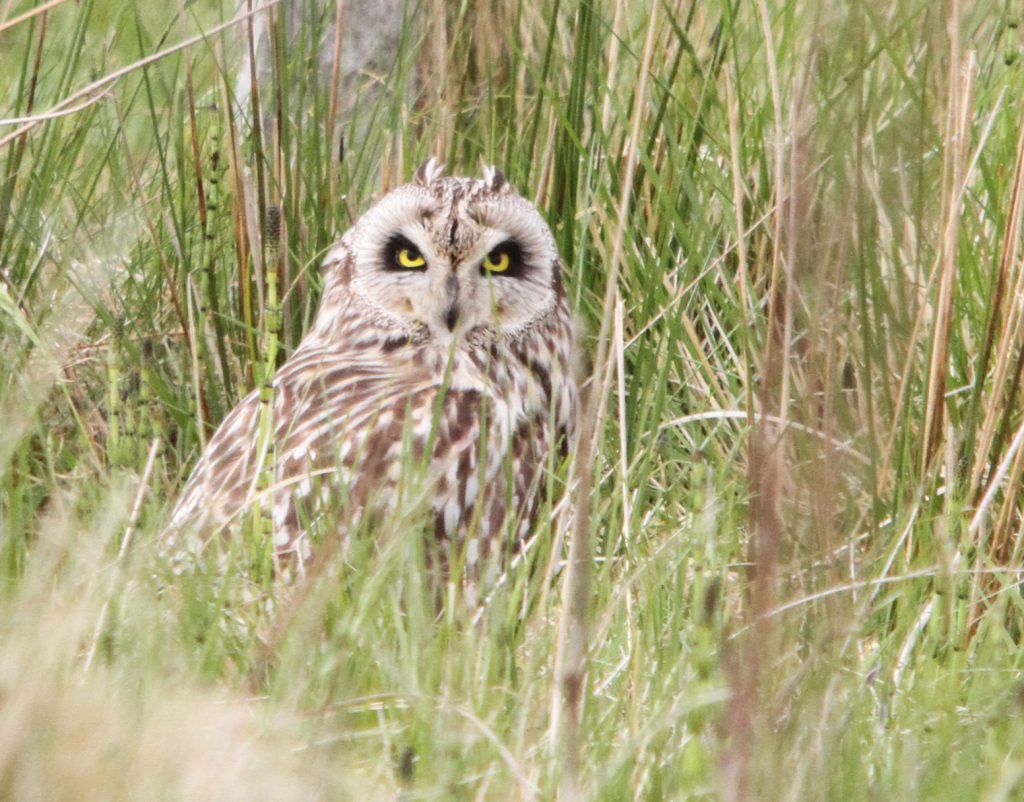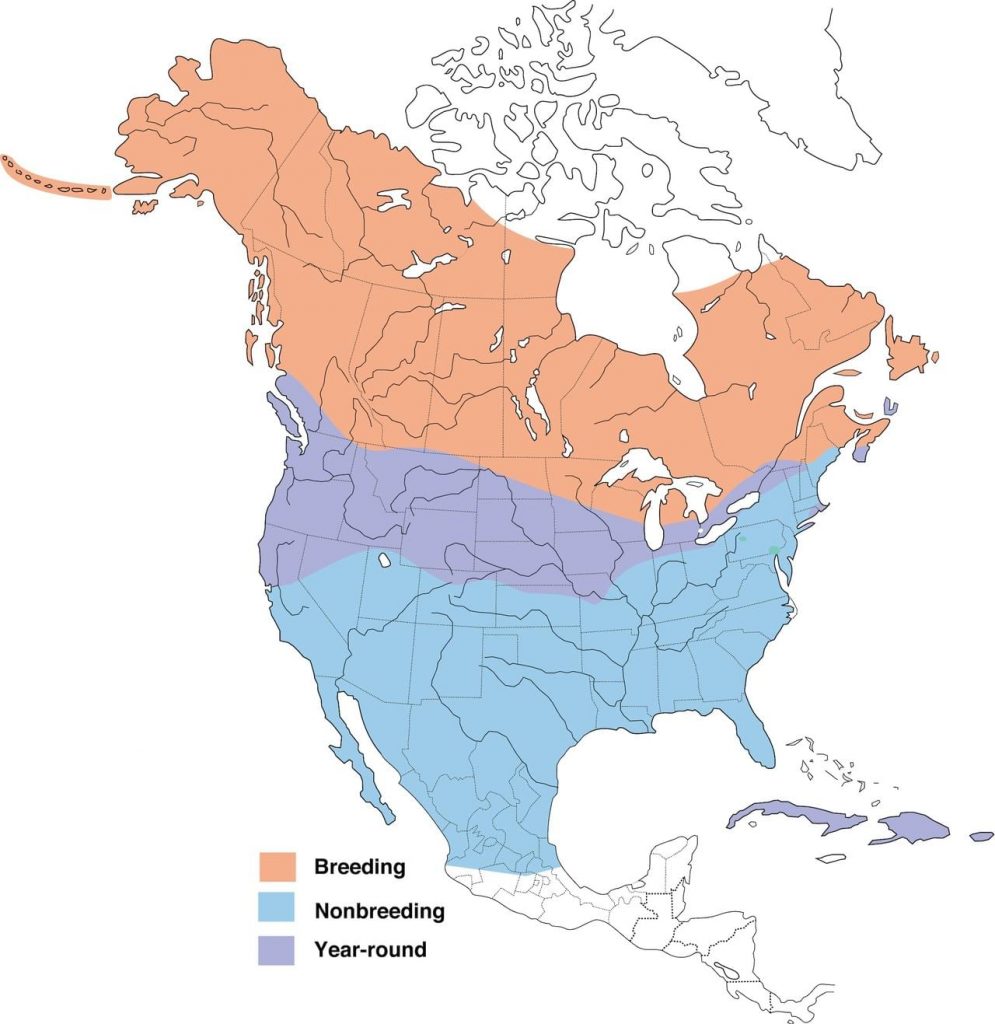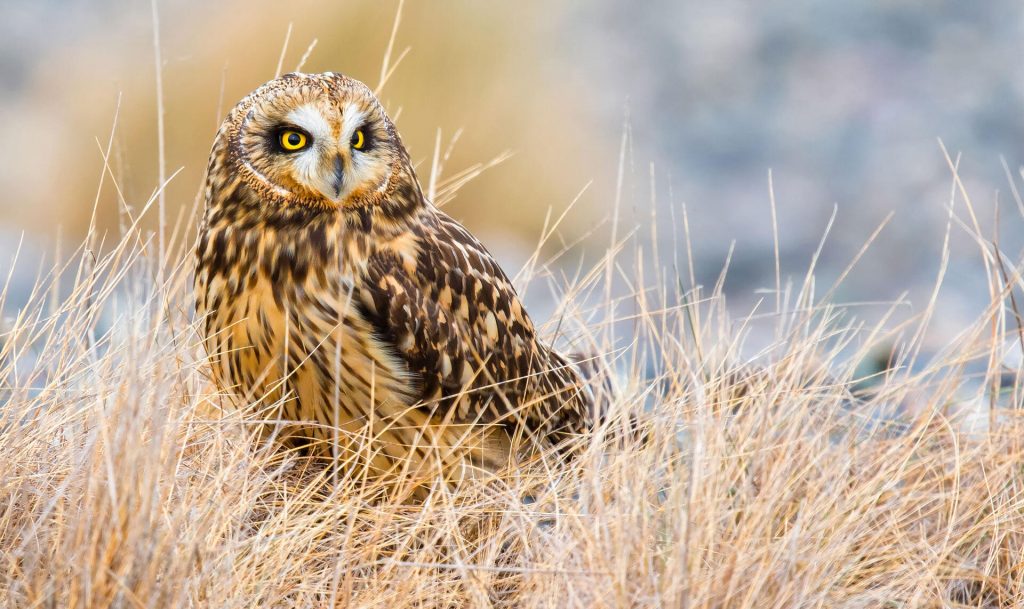An Introduction to the Short-eared Owl
The sun is shinning and you are done with being in your house all day staring at your computer screen. You decide to take a walk outside to the grassland behind your house. As you are walking along, you stumble and fall to the ground. You look back and see a hole in the ground, you have no idea what it might be. So you continue to hobble along with your sore ankle and see a Short-eared Owl in the distance sitting in the grass. When you go back to your house, you search Short-eared Owls and realize that the hole you tripped on was their nest (thankfully it was a nest from the year previous and you did not crush any eggs). From that day forward you referred to the Short-eared Owl as ankle breaker. Please be careful when walking in grasslands, both for your sake and for the owls.

DESCRIPTION AND IDENTIFICATION
The Short-eared Owl (Asio flammeus) is a member of the Order Strigiformes and Family Strigida (Cornell University: All About Birds). The meaning of flammeus, is “fiery” and it refers to the boldly streaked plumage (American Bird Conservancy). The English name of the Short-eared Owl comes from the two small feather tuffs on the top of it’s head.
Short-eared Owls are medium-sized owls with round heads. They have broad wings with rounded tips and a short tail. The plumage on Short-eared Owls is brown spotted with buff (light brown) and white on the upperparts. They have yellow eyes with black outlines and a pale face. The chest and belly of Short-eared Owls are pale and they have a heavily streaked brown chest. The underwing of Short-eared Owls is pale with a dark-comma shaped mark near the wrist (Cornell University: All About Birds).

HABITAT AND DISTRIBUTION

Short-eared Owls are found in various parts of the world, including North and South America, Europe, Asia and on oceanic islands. (American Bird Conservancy). In North America, the Short-eared Owl can be seen year round in a strip in the middle of the continent, due to the overlap between the breeding and wintering range (Cornell University: All About Birds). In the winter, the number of Short-eared Owls in an area depends on the abundance of food. Often they will have communal roosts and up to 200 birds have been recorded (American Bird Conservancy).
Figure 3: Distribution of Short-eared Owls in North America. Photo from: Cornell University: All About Birds.
Interesting Fact: The only native owl in Hawaii is a subspecies of the Short-eared Owl called the pueo (Asio flameus sandwichensis). Pueos have been thought to descend from the Alaska forebears and that they claimed the islands when Polynesians brought Pacific rats, which were a food sources for the pueos (Cornell University: All About Birds).

Short-eared Owls live in low vegetation areas with large, open spaces, which include prairie and coastal grasslands, heathlands, meadows, savanna, tundra, marshes, dunes and agricultural areas. In the winter, Short-eared Owls live within woodlots, fields, fresh and saltwater marshes, gravel pits, and rock quarries (Cornell University: All About Birds).
GENERAL BEHAVIOUR
Short-eared Owls are active mainly during low-light conditions (dawn and dusk) and roost in trees, making Short-eared Owls easier to spot than most owls; however, it is still hard to see them (Cornell University: All About Birds and Audubon). These owls are able to maneuver in the air and drop quickly to capture prey. Short-eared Owls mainly eat birds and small mammals, in particular mice and vole. Short-eared Owls are also able to soar using their long, broad wings. The ability to soar is beneficial for migratory travel of these owls (Cornell University: All About Birds).
NESTING BEHAVIOUR
Short-eared Owls make their nests on the ground in a dry area within grasses and low plants.
Interesting Fact: The Short-eared Owl is one of the only owls that constructs it’s own nest. The nest consists of a bowl dug out of the ground that is covered in grasses and downy feathers from the owl. The average size of a nest is ten inches across and two inches deep.
The clutch size of Short-eared Owls is between 1-11 eggs and they usually have 1-2 broods a year (Cornell University: All About Birds). The incubation time is done by the female owl and is between 24-37 days (Audubon). The male will feed brooding females and provided protection for the nest by being a distraction through displays and vocalizations (Cornell University: All About Birds). Young will leave the nest on foot around 12-18 days after being hatched and can fly around after 27-36 days (Audubon). By leaving the nest earlier the amount of time the young are vulnerable to predators is reduce (American Bird Conservancy).

The behaviour of Short-eared Owls, like many species, varies during breeding season. In breeding season, the owls are active all day and night. Breeding Short-eared Owls will roost in the tall grass on the ground. These owls are colonial breeders which means they breed in larger groups, but they breed with only one mate per season. The male Short-eared Owls perform sky dances to try and attract the attention of the female. Sky dances consist of singing, wing-clapping and aerial movements. I had a hard time finding a good video where you could hear and see the wing-clapping. The following video is a brief introduction to Short-eared Owls, but at approximately the 1:13 mark there is a great shot of a male doing wing-clapping.
CONSERVATION
In 2019, there were 600,000 Short-eared Owls in North America and 2 million worldwide (American Bird Conservancy). The overall population of Short-eared Owls has remained stable between 1966 and 2015. The Short-eared Owl was listed on the Common Bird in Steep Decline in 2014 (Cornell University: All About Birds). Currently in Canada, the Short-eared Owl is a species of special concern, with the status that it may become threatened or endangered due to biological and identified threats (Nature Conservancy Canada and COSEWIC). The major cause of decline in the Short-eared Owl population is due to habitat loss from agriculture, livestock grazing, recreation and development. Short-eared Owls are sensitive to habitat loss and fragmentation as they need large, uninterrupted, open areas (Cornell University: All About Birds).
Research Areas
SEASONAL MOVEMENTS THROUGH SATELLITE TELEMETRY
Short-eared Owls have facultative migratory behaviour and are nomadic, which means it is irregular and depends on environmental conditions (Johnson et al., 2017 and Booms et al., 2014). The movement of Short-eared Owls depends on the amount of prey available in the area. In June 2009 and July 2010, satellite transmitters were attached to adult Short-eared Owls, located in breeding areas in western and interior Alaska (Johnson et al., 2017). The movement of these owls was then monitored for up to nineteen months (Johnson et al., 2017). The study showed that the Short-eared Owls that breed at northern latitudes migrated a lot because the snow in the winter covers up the prey (Johnson et al., 2017 and Booms et al., 2014). Short-eared Owls at temperate latitudes were more likely to stay there year-round, depending on the environmental conditions (Johnson et al., 2017). The study showed that Short-eared Owls can live in a variety of habitats, as we learned earlier (Johnson et al., 2017). In North America, the Short-eared Owls have shown a decline and are a conservation concern (Johnson, 2013). Conservation efforts require a continental-scale focus, as the threats to Short-eared Owls include loss, fragmentation and degradation of grasslands and wetlands (Booms et al., 2014).
The study recognized that putting transmitters on birds can affect them, both short-term and long-term effects (Johnson et al., 2017). However, there was no obvious negative effects on the owls from the transmitters (Johnson et al., 2017). The majority of the owls, 92%, survived the initial summer period and the mortality rate increased during migration (Johnson et al., 2017). Raptors have been documented to have higher mortality rates during migration than when they are in the same area (Johnson et al., 2017). Although the transmitters could have reduced the owl’s maneuverability and increase their vulnerability to predation, the cause of the owl’s death was probably due to predation (Johnson et al., 2017). The natural predation rates of Short-eared Owls are unknown, but there are multiple raptor species that are known to hunt Short-eared Owls (Johnson et al., 2017).
ECOLOGICAL VARIABILITY AND HABITAT FEATURES
There are two aspects of Short-eared Owls that make it more vulnerable to decline, reliance on intact grasslands and unpredictable food resource (Booms et al., 2014). Grasslands in North America are an endangered habitat (Booms et al., 2014). Small mammals, prey for Short-eared Owls, are an unpredictable food source as they vary spatially and temporally (Booms et al., 2014). The Short-eared Owls choice in prey, depends on the abundance of which species is in the hunting range (Dupal and Chernyshov, 2012 and Johnson, 2013). If the small mammals are abundant, Short-eared Owls can feed on prey at high quantities. If the small mammal population is low, the Short-eared Owls do not breed or will leave the area.

A study was done on two islands near Kingston, in eastern Ontario, Canada which consisted of Short-eared Owls nesting behaviour (Keyes and Gahbauer, 2016). The researchers detected courtship display as that is a very visible behaviour of Short-eared Owls (Keyes and Gahbauer, 2016). Before a month passed after seeing the courtship display, the researchers searched for a nest (Keyes and Gahbauer, 2016). After finding a nest, they characterized it and the area surrounding it. The study showed that fencing with wooden posts was dominant in many of the territories, which may suggest that wooden posts are good perches for the breeding season (Keyes and Gahbauer, 2016). The nest sites were in pasture and hay fields, and taller vegetation surrounding the nest was common (Keyes and Gahbauer, 2016). The tall vegetation is likely an extra protection barrier from predators. Choosing a nesting area is very important to determine the success of the young. Short-eared Owls evaluate environmental conditions as well as food source (Dupal and Chernyshov, 2012). It is important to remember that effective monitoring of Short-eared Owls is difficult due to continental-scale movements, variability in local abundance, difficulty in finding nests and only being active around sunset and sunrise (crepuscular activity) or at night (nocturnal activity) (Johnson, 2013). Future research is needed to continue to monitor the Short-eared Owls and determine the best strategies of conservation.

Concluding Thoughts
I hope you enjoyed learning about Short-eared Owls as much as I did. Short-eared Owls are amazing birds and we can do our part to protect them, through conserving their habitat areas. Although Short-eared Owls are tough to spot, I encourage you to keep an eye out for them. Also please be careful when walking through Short-eared Owl’s habitat areas, we do not want anymore broken ankles. Thanks for reading!
Hey Danielle,
Great blog! I love your intro, very fun way to start such an informative blog! There was an overwintering bird in the estuary near my home and last year I took advantage of our many snow days to go and watch the SEOW flying around the field. My dream would be to catch and band one I think I would quite possibly die from the overwhelming joy.
I love the photos you included on the young nestling, too cute!! Your adult photos are nice as well, and show quite a range in plumage variation. Do you know if these are just colour morphs or is it due to geographic variation? The video was also really neat. I didn’t know they clapped their wings together for display! I find it a bit funny, given that owls are so well known for their silent flight.
I enjoyed your summary of the research on seasonal movements. Seems like we have much to learn! I appreciate the research commenting on survival effects of transmitters. Do you know if the transmitters used were large relative to body size? I feel like for some birds, the transmitters look ginormous (even though they are still relatively light).
Well done, and thank you for sharing your love of these beautiful owls!
Cheers,
Samuelle
Hey Sam,
Thank you so much for reading my blog and the wonderful comments you have provided me with!
In regard to plumage, there is a variation depending on geographical range. I also believe there can be some minor plumage differences between individuals. The Northern Short-eared Owl tends to be heavily streaked and have dark eye patches with a white face. The Hawaiian Short-eared Owl has a variation in plumage colour and is often streaked and spotted looking, while still have dark eye patches and a white face. There are also Galapagos Short-eared Owls which overall have a darker plumage. Antillean Short-eared owls are also darker in plumage and tend to be a darker brown on top and lighter brown on the bottom.
The transmitters used were on average 3.0% the weight of the owl itself. The size was about 2mm thick and 5x7cm in dimension. In my opinion this is not huge compared to the size of the owls, but it definitely is not small either.
Thanks again for the questions and reading my blog!
Danielle
Hi Danielle,
I really enjoyed reading your blog! It would be absolutely amazing to see one of these raptors out in the wild!
You mentioned that these birds are becoming more threatened/ endangered due to habitat loss, is there any places/ policies that are trying to help conserve them?
Cheers,
Madison
Hey Madison,
Glad you enjoyed reading my blog. Thanks for reading it! I agree, I’d love to see one in the wild.
In regard to your question, I found a document from Government Canada from 2016 that is a management plan for Short-eared Owls. Here is the link to it: https://www.registrelep-sararegistry.gc.ca/virtual_sara/files/plans/mp_short-eared_owl_e_proposed.pdf
The main management strategies that I got from the document is that management plans are being made for certain areas, and that conservation plans are in place. Also, that guidelines and policies are made for industries and development areas.
Hope that answers your question! Thanks again for reading my blog.
Danielle
Hi Danielle,
I liked your personal connection to the title, ground nesting seems like an interesting choice. Are their nests just indentations in the ground or more like the burrows that burrowing owls make?
Really great article,
Danielle
Hey Danielle,
Thank you for reading my blog. Thankfully I haven’t fallen in a Short-eared Owl nest, but if I did I probably would roll my ankle. To my understanding they are indentations in the ground. Sometimes when in the long grasses it is like a burrow of grasses (hope that made sense).
Danielle